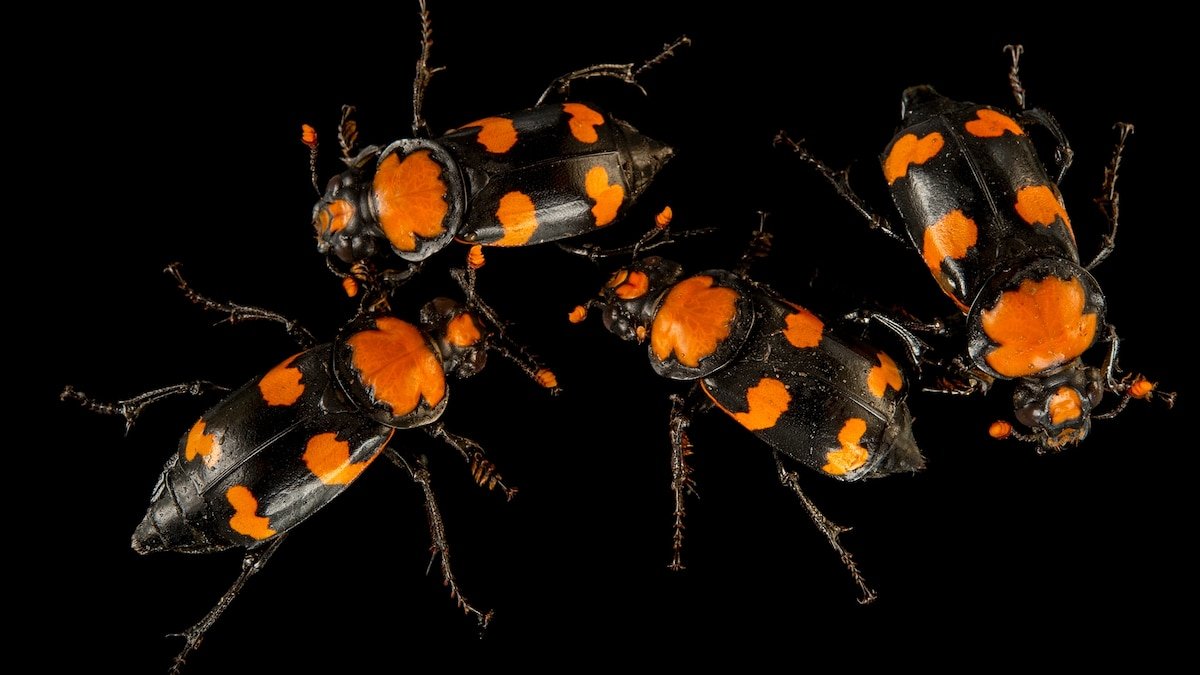Among the latest contenders in the fight against drug-resistant infections is a striking, black beetle with fiery red spots and orange-tipped antennae. Known for spending much of its life underground, the little-known American burying beetle could hold the key to developing the next generation of antibiotic treatments.
For the past two decades, researchers have investigated how the beetle preserves meat at room temperature, seeking to harness its antibacterial, antifungal, and food preservation properties for human use. Now, scientists have discovered a new super power: These beetles are even resistant to powerful deadly insecticides, a finding that raises even more excitement about studying the beetle to discover new life-saving drugs.
The beetles can survive exposure to powerful insecticides
The soil-dwelling American burying beetle traffics in death, a lifestyle that regularly exposes it to a myriad of pathogens.
For example, to feed its young, it scavenges small pathogen-laden dead animals like mice, prairie dogs, and birds. After sniffing out a carcass from up to two miles away, the beetle joins a mate in burying the dead animal, removing its fur or feathers, rolling it into a ball, and covering it in oral and anal secretions that keep it fresh for weeks or more. The brood ball serves as a shelter and food source for future young that the pair raises together, a unique example of biparental care in the insect world.
But as crafty and resilient against germs as they are, the beetles are threatened by habitat loss and environmental change. A recent study in PLOS One, sought to figure out how neonicotinoids, the most common type of insecticide in the United States, impact the beetle. Derived from nicotine, this class of insecticides, which is prohibited in the European Union, helps control pest populations by disrupting their neurotransmitters but can also have the same effects on other non-pest insects like burying beetles.
(Cicadas are back—and this time it’s the ‘mother of all broods’)

LIMITED-TIME EARTH MONTH OFFER
Get a bonus issue with all magazines
The study’s scientists had previously studied and documented how adult dung beetles usually die from exposure to neonicotinoids, and were curious to see if another type of burying beetle would face the same fate.
To their surprise, the research revealed that beetles exposed to neonicotinoids recover surprisingly quickly, suggesting they possess unique detoxification abilities.
“They roll over on their back, they twitch, they’re hyperactive, they extend their wings without flying,” says study co-author Wyatt Hoback, an entomologist at OSU . They squirm but they don’t die like most other insects would. “Most of the time, that set of symptoms leads to the death of the insect. But interestingly, with the American burying beetle, they act intoxicated and like they’re going to die for a day, and then the next day, they’re back to normal.”
Their resilience could be a bit clue to new drugs
The scientists had two big takeaways from the findings. First, it’s not all good news. Sure, the beetles can survive the poison. But the altered behavior it causes leaves them vulnerable to predator attacks and reduces the time they spend feeding, pointing to the need to reduce their exposure to neonicotinoids in the wild. Federally listed as endangered in 1989, conservation and reintroduction efforts have increased the beetle’s numbers across parts of its historic range in the northeastern and midwestern U.S., leading to its downlisting to threatened in 2020. Reducing exposure to pesticides will help maintain their recovery.
Second, the researchers were surprised by the beetle’s impressive ability to bounce back after being poisoned. Hoback who has been studying the beetle for more than 25 years, says the findings further his belief that the beetle’s holds exciting medical promise for humans.
You May Also Like
Since the beetles they were testing had never encountered insecticides before, the researchers believe the beetles evolved biological detoxifiers due to their unique lifestyle. They suspect that frequent exposure to meat-eating bacteria and other pathogens may have led the species to develop a natural defense system to shield itself from harmful substances.
Now, the researchers are studying the genome and microbiome of the beetle, including its oral and anal secretions, to pinpoint the unique genes and bacteria that help the beetle detoxify neonicotinoids and preserve meat at room temperature. So far, the scientists have cultured 11 different species of bacteria from the beetle, one of which is a species completely new to science. Molecular sequencing can identify the bacteria but then the scientists must study how the bacteria work.
The poisoned beetles may have more to teach us
These questions could, one day, yield treatments for stubborn and deadly problems. Methicillin-resistant Staphylococcus aureus, or MRSA, is a type of staph that can be resistant to several antibiotics. A concerning problem in hospitals and with pro-athletes, the aggressive pathogen can eat away at living flesh.
“If we could find the way that the beetles deal with everything from gangrene to staph aureus in the environment, then we have the possibility of being able to sequence the specific proteins that are involved and make that into a medication,” Hoback says.
(California’s sea lions aren’t really ‘demonic’—they’ve been poisoned)
The researchers are interested to keep studying the beetles that were exposed to the insecticide and then recovered, looking at how the exposure may have triggered lifesaving genes to turn on. This “upregulation” process could leads to the production of more proteins that can help address environmental threats like toxins or meet other cellular demands.
Immo Hansen, a molecular biology professor at New Mexico State University who has collaborated on American burying beetle studies with Hoback, believes that based on these new findings and past ones that the beetles and their microbes could hold the key to the next generation of antibiotics. “They must have antibacterial properties that could be used to fight bacterial infections in humans,” he says.
Whether the beetles are exposed to insecticides or rotting flesh, their physiology comes to their rescue, most likely in the form of gene upregulation that protects and keeps them healthy, an ability that could greatly improve human health if better understood.
“We have to identify which parts of that are of most interest for human benefit,” says Hoback.
“Is it the bacteria or the beetle itself expressing enzymes that allows recovery,” asks Hoback.
A version of this story appears in the May 2025 issue of National Geographic magazine.
The nonprofit National Geographic Society, committed to illuminating and protecting the wonder of our world, funded Explorer Joel Sartore’s work. Learn more about the Society’s support of Explorers.











